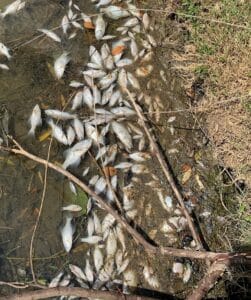Caution: Pond treatments during hot weather can kill your fish!

Oxygen Related Fish Kill
Due to the extreme heat here in north central Texas, there are times when caution should be taken when treating algae and aquatic vegetation. During the dog days of summer, un-aerated ponds and lakes hold very little dissolved oxygen and fish often ride a fine line between survival and death.
The chemical treatment of algae and aquatic vegetation can further reduce oxygen levels in a pond. Although the products themselves do not harm fish, the decomposing material left behind after the treatment does. The biological process of decomposition strips valuable oxygen from the water column. Therefore, treating large areas of algae or vegetation under summertime conditions can tip the oxygen balance below the critical level. As a result, EPA product labels prohibit treating all of a pond at once. Treatments should take place in sections with 10-14 days allowed between partial treatments.
Dissolved oxygen declines during periods of hot or cloudy weather
Dissolved oxygen levels are influenced by water temperature, degree of sunlight, water clarity, wave action, and time of day. Under normal conditions, we have plenty of sunlight penetration into the water. Direct sunlight allows aquatic plants, desirable algae, and phytoplankton blooms to produce oxygen through photosynthesis. However, one or two overcast days combined with extreme heat causes the dissolved oxygen levels to drop.
Dissolved oxygen also fluctuates on a daily basis. Oxygen levels are highest in late afternoon after several hours of direct sunlight. Conversely, they are lowest just before the sun rises. This is because aquatic plants and algae consume oxygen overnight while photosynthesis is shut down. Un-managed ponds with excessive algae or aquatic weed growth have the most significant 24-hour oxygen fluctuations. In fact, severe infestations can cause fish kills even when no other factors are involved.
Shallow ponds + hot weather = more fish kills

Summer 2022 Fish Kill
High water temperatures alone can also cause fish kills. In fact, research shows that adult largemouth bass can begin to die once water temperatures exceed 90 degrees. Likewise, bluegill can begin to die once temperatures reach 95 degrees. Therefore, direct heat related fish kills are common here in north Texas. These are most likely to occur in shallow ponds that do not provide escapement to deeper, cooler water. Pond depth is critical since storm-water ponds often drop several feet over the summer due to evaporation. Ponds deeper than 8 feet over at least 25% of the area are less likely to have kills due to extreme water temperatures.
Keeping an eye on the weather is an important part of pond and lake management. We recommend halting all algae and aquatic weed treatments during extended periods of hot weather conditions. Unfortunately, these are the same weather conditions that can fuel the out-of-control growth of noxious algae. But it is better to tolerate the eyesore than deal with a pond full of dead, smelly fish. Disposal options for dead fish are limited and you will likely be reliant on Mother Nature to clean up the remains. Treatments should also be halted during extended periods of cloudy weather. These decisions are best for the long-term health of your pond.
Below are some tips for minimizing the risk of oxygen depletions:
- Minimize the use of landscape fertilizer near the pond during summer months.
- Bag all grass clippings and other landscape debris.
- Do NOT mow all the way to the shoreline edge.
- Consider preserving desirable aquatic plants for added oxygen production.
- Consider operating fountains/aeration for 24 hours a day during extended heat spells.
